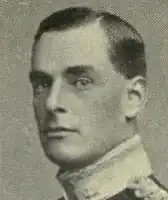Julian Hasler
Brigadier-General Julian Hasler (16 October 1868 – 27 April 1915), was a British Army officer in World War I.
Julian Hasler | |
|---|---|
 | |
| Born | 16 October 1868 Aldingbourne House, Chichester |
| Died | 27 April 1915 (aged 46) Ypres, Belgium |
| Allegiance | United Kingdom |
| Service/ | British Army |
| Years of service | 1888–1915 |
| Rank | Brigadier-General |
| Unit | East Kent Regiment |
| Commands held | 11th Infantry Brigade |
| Battles/wars | South African War First World War |
| Awards | Mention in Dispatches |
| Relations | William Wyndham Hasler (father) |
Early life
Julian Hasler was born in Aldingbourne, West Sussex on 16 October 1868, the second son of William Wyndham Hasler, a wealthy landowner and Justice of the Peace for Sussex, and Selina Sarah Hervey, a member of the extended family of the Marquess of Bristol. After spending his early year at Aldingbourne House, his ancestral home, he attended Winchester College from 1882 to 1885.[1]
Military career
After the academy, Julian Hasler was commissioned into the 1st Battalion of the East Kent Regiment, on 19 September 1888,[2] and soon promoted to lieutenant on 4 February 1892.[3] From 1895 he was almost uninterruptedly in active military service, first with the Chitral Relief Force (1895), then the Northwest Frontier in India[4] as a captain (1897-1898, where he participated in the capture of the Tanga Pass), in South Africa (1900-1902) where he raised the Hasler's Australian Scouts, briefly in Nigeria where he documented a new species of Red-fronted gazelle,[lower-alpha 1] and in West Africa (1899-1900, 1903–1910).[1]
He was wounded several times and mentioned twice in dispatches because of his bravery.[6] He was promoted to major on 7 February 1907[7] and to lieutenant colonel on 4 August 1914.[8]
First World War
After the outbreak of the war, he was promoted Brigadier-General and sent to France in September 1914. There, he was given command of the 1st Battalion of the Buffs. Wounded in October of the same year, he briefly returned home for convalescence. In December he went back to the front, where he was in command of the 11th Infantry Brigade. He distinguished himself for gallantry and resilience and was mentioned in dispatches twice by Field Marshal Sir John French.[9]
Death
The 11th Brigade was operating as part of 4th division in the area of Ploegsteert Wood, Belgium close to the French Border. On 24 April 1915 it was sent north to reinforce the 5th Corps in the Ypres salient and was subsequently attached to 28th Division, taking over the front line between BERLIN WOOD and FORTUIN. On 27 April 1915, Hasler fell in action at St. Jean, near Ypres in Belgium, in the context of the Second battle of Ypres, being the second general to die because of heavy shelling of an advanced headquarter that was placed too close to the salient.[10] His commanding officer, Major-General Edward Bulfin, had ordered him to abandon the position after dark on that same day, but he was delayed and was killed around 9pm that evening.
"I saw poor Julian Hasler on the 27th April; the place was being heavily shelled. I sent him up Grogan and Le Preu, my GSO2 and GSO3, to help him, and some signallers, but all the lines were constantly cut so I ordered him to get out as soon as it was dark. He was killed about 9 p.m. that night: he could have got out at 6 p.m., but delayed"
— General Bulfin, commander of the 28th Division[11]
His death features in a number of war diaries of the time.[12][13] He left a wife, Edith Gwendolin Orr-Ewing, and two young children.[1]
Notes
- Hasler presented the discovery to the London Zoological Society in 1908 and the new taxon was called Gazella Rufifrons Hasleri.[5]
References
- "Hasler, Julian". Winchester College Roll of Honour. Retrieved 11 November 2022.
- "No. 25857". The London Gazette. 18 September 1888. p. 5218.
- "No. 26270". The London Gazette. 22 March 1892. p. 1702.
- Simnar, Mark (2017). Pathan Rising: Jihad on the North West Frontier of India 1897-1898. Fonthill Media. ISBN 978-1781555408.
- Proceedings of the London Zoological Society. 1912. p. 5.
- London Gazette, 15 November 1901 and 18 September 1906
- "No. 28004". The London Gazette. 15 March 1907. p. 1833.
- "No. 29047". The London Gazette. 22 January 1915. p. 702.
- London Gazette, 17 February and 22 June 1915
- Dixon, John (2003). Magnificent but not war: The Second Battle of Ypres 1915. Pen and Sword Books. ISBN 978-1783034642.
- Davies, Frank; Maddocks, Graham (2014). Bloody Red Tabs: General Officer Casualties of the Great War 1914–1918. Pen and Sword Books. ISBN 978-1473812512.
- Thompson, Bill (2015). Morland – Great War Corps Commander: War Diaries & Letters, 1914-1918. Troubador Publishing. p. 69. ISBN 978-1784622787.
- Crozier, Frank Percy (1930). Impressions and recollections. T. W. Laurie. p. 143.